If you frequent my blog, then yo know last week I released blog post all about how you can use poem of the week as a way to promote comprehension. I explained what poem of the week is, why it’s important, and how you can use a very quick and easy weekly routine to empower students to understand and enjoy reading poetry.
Well you can use the same poem of the week routine, but put a fluency focus on it.
Fluency is one of the core attributes of a successful reader. It’s something that gets a lot of attention in lower elementary, but not as much in upper elementary. We sometimes assume that students will show up in 3rd, 4th, or 5th grade already fluent.
Even if you don’t have students who struggle with fluency, it is something you should give attention to in upper elementary. Why? Fluency is essential for comprehension and enjoyment of reading – two things most reading teachers really care about.
The good news is there is a quick and easy way to focus on fluency – poem of the week. With poem of the week you can easily give attention to fluency without sacrificing a ton of time. Before I jump into the fluency routine, let’s quickly chat about what fluency is and why it’s important.
What is fluency?
Fluency is the ability to read words automatically, correctly, smoothly, and with expression. When students are fluent readers they see a word and they automatically know how to read that word. They don’t need to pause and sound out or decode the word in order to read it. They also know where in the text they should pause. They pay attention to commas, periods, and other punctuation marks and know how to “read punctuation” in order to communicate meaning.
Why is fluency important?
In order for students to comprehend and understand what they read, they have to be fluent readers. Comprehension is significantly impacted by how students read a text. If students aren’t fluent, that means they are either reading the words incorrectly, or they aren’t phrasing them correctly.
Automatically grouping words is how we extract and form meaning from what we read. Have you ever had a student who wants to pause at the end of every single line in a text – even if there isn’t a comma or period there? What about a student who reads like a robot and doesn’t read the words smoothly? Both of those are signs that students struggle with fluency. And my guess is that if they struggle with fluency, they also probably struggle with comprehension.
If you can help your students learn how to be more fluent and automatic readers, there is a good chance you’ll also be helping them improve their understanding of what they read…. which also might help them enjoy reading just a little bit more.
Using Poem of the Week as a Fluency Activity
Let me break down a weekly routine that you can use with any poem to help your students work on their fluency. Most of the time students will really enjoy fluency practice. It can be fun and often feel like it’s a game or a performance.
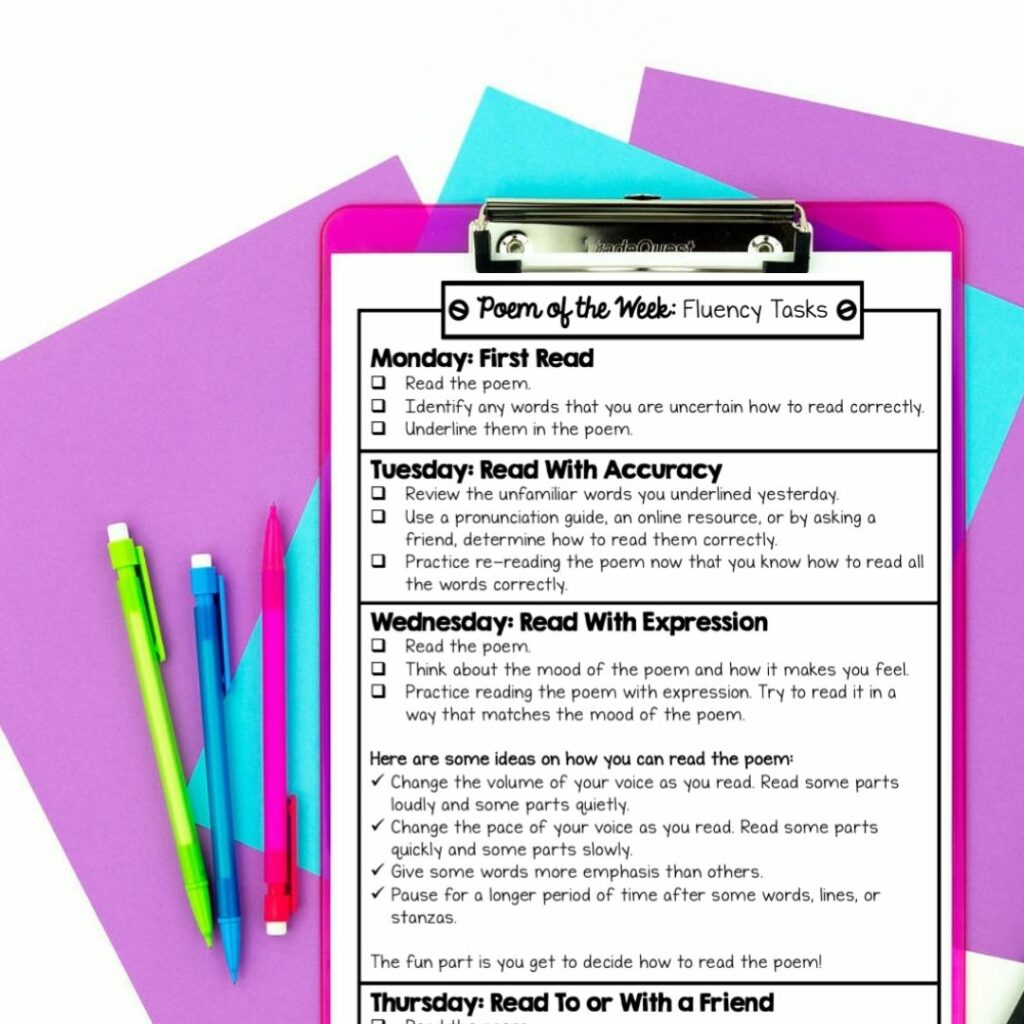
Monday: First Read
Student Daily Fluency Activity:
- Read the poem.
- Identify any words that you are uncertain how to read correctly.
- Underline those words in the poem.
How this helps students: In order for students to be fluent readers they first have to be accurate with what they are reading. Later in the week, students will really focus on their pacing and expression. But before we get to that point, we want to make sure that students KNOW how to read each word in the poem.
Tuesday: Read With Accuracy
Student Daily Fluency Activity:
- Review the unfamilair words you unerlined yesterday.
- Use a pronunciation guide, an online resource, or by asking a friend, determine how to read those words correctly.
- You can even look for familiar word parts, word families, word endings, and root words to see if you can pronounce the word correctly on your own.
- Once you have figured out how to read all of the words, practice re-reading the poem now that you know how to read all the words correctly.
How this helps students: Rereading is a great way for students to practice their fluency. Anytime they reread a text they are becoming more “automatic” in their reading and grouping of the words. This automatic reading and grouping of words help students gain meaning from what they are reading…. so really, fluency is necessary for comprehension.
Ultimately we want students to be fluent, but we also want them to be accurate. So on day 2 and beyond, they should be able to read the poem correctly and fluently.
The tasks on this day also give students an opportunity to use resources (dictionaries or classmates) to help them read any unknown words. This helps students realize that it’s ok if you don’t always know a word you see in a text. When that happens, you can use resources to help learn how to read it correctly.
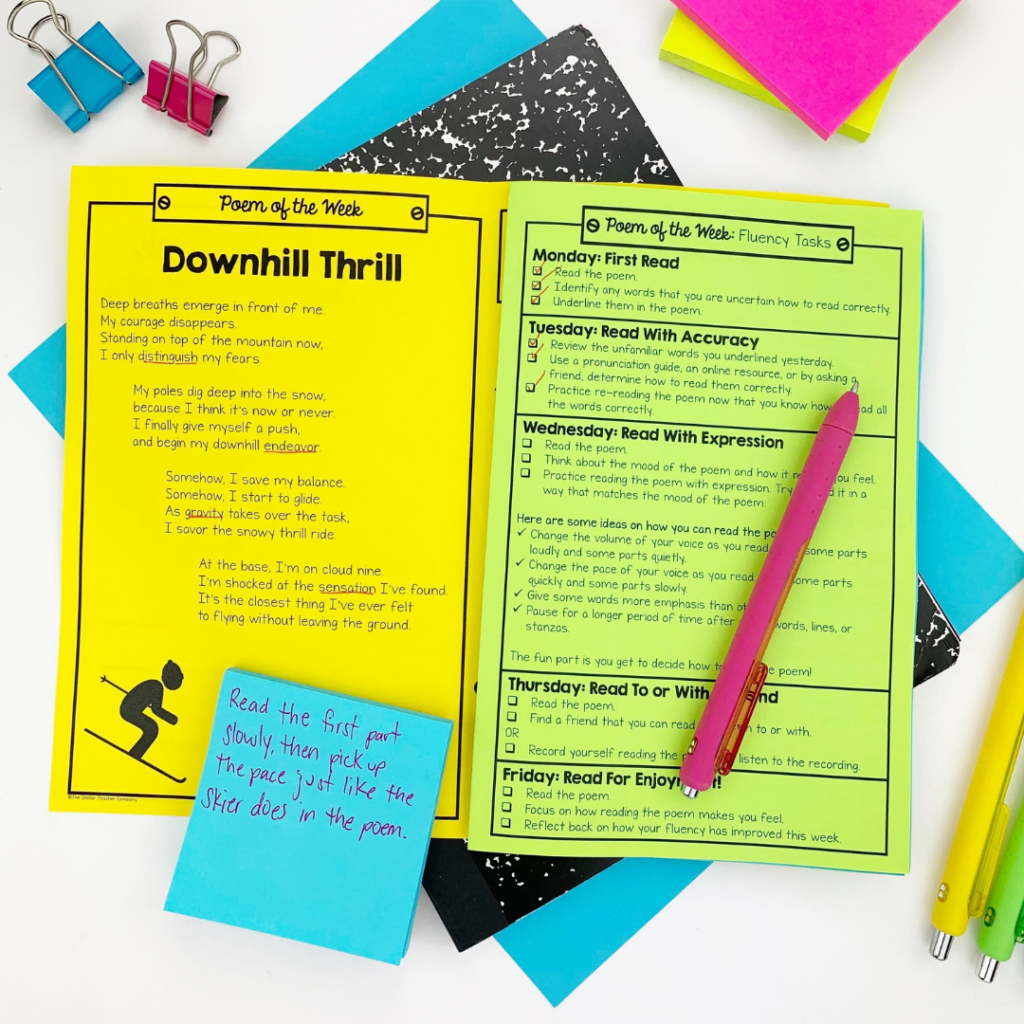
Wednesday: Read With Expression
Student Daily Fluency Activity:
- Read the poem.
- Think about the mood of the poem and how it makes you feel.
- Brainstorm ways that you could read the poem so it matches your mood as a reader.
- Practice reading the poem with expression. Try to read it in a way that matches the mood of the poem.
Here are some ideas on how you can read the poem:
- Change the volume of your voice as you read. Read some parts loudly and some parts quietly.
- Change the pace of your voice as you read. Read some parts quickly and some parts slowly.
- Give some words more emphasis than others.
- Pause for a longer period of time after some words, lines, or stanzas.
The fun part is you get to decide how to read the poem!
How this helps students: This is a fun day for students because they start to get creative with their reading and can experiment with expression and pacing. By now, students have read the poem at least 3 times so they should feel pretty fluent in their reading and they should also have a basic understanding of the poem which means they can practice using their oral reading as a way to help communicate the meaning of the poem.
On this day, it can be fun to let students practice reading the poem in a few different ways. Have them pay attention to how the poem sounds and feels when they change the volume, pacing, and intensity of their voice.
Thursday: Read to or With a Friend
Student Daily Fluency Activity:
- Read the poem.
- Find a friend that you can read the poem to or buddy ready with.
- OR You can also record yourself reading the poem and then listen to the recording.
How this helps students: Today students will get a chance to read the poem to or with a friend. Both can be beneficial. If students “perform” their poem for a friend they will get a chance to show of their expression plan they made the day before. It’s also a chance for them to hear how their classmates chose to read the poem and they can see if anyone else read it in a similar way to them.
Buddy reading can also be really beneficial because it gives students a chance to match their pacing and reading with someone else. This can be really great for the practice of “automatic reading”
Friday: Read for Enjoyment
Student Daily Fluency Activity:
- Read the poem.
- Focus on how reading the poem makes you feel.
- Reflect back on how your fluency has improved this week.
The goal for today is simply for students to read the poem another time and to reflect on how their fluency has grown or changed throughout the week. By Friday they should feel so much more confident in their reading of the poem. They should be able to articulate how their fluency has improved during the week. It is an easy way for students to identify growth in their reading.
So there you have it. Poem of the week as a way to promote fluency.
The good news is that this fluency routine only takes a few minutes each and everyday. AND you could even use this same routine for a short text if you didn’t want to focus on a poem each week…
Hope you and your students love this routine!
Happy Teaching!


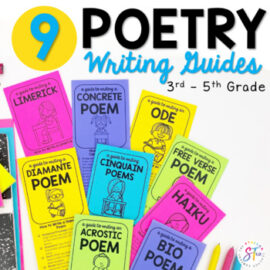
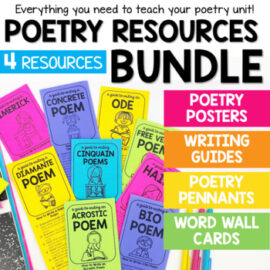


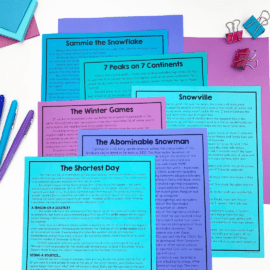
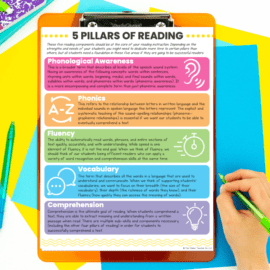









Leave a Comment
You must be logged in to post a comment.